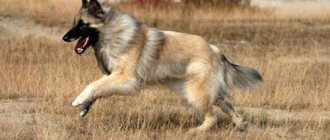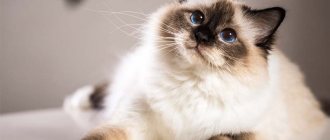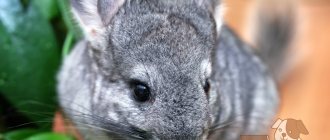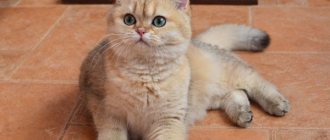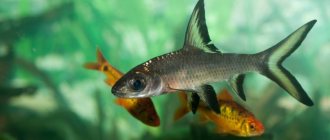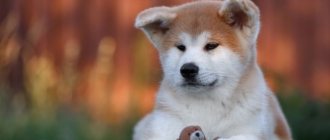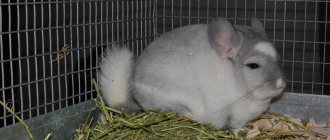Even in ancient times, people, realizing how useful animals can be, began to domesticate them. Among pets, there are those that we get for our benefit, and there are pets for the soul.
Often, pets become so close to us that we treat them as members of our family.
Nowadays, it is difficult to surprise anyone with the presence of an exotic animal in the house. And you definitely won’t surprise anyone with a funny animal, a chinchilla. But just recently this exotic animal was wild.
Description of chinchilla
The chinchilla's appearance makes it look like a large squirrel. These animals have very soft fur, large eyes and ears.
The chinchilla has a long tail (up to 17 centimeters). The hind limbs are longer than the front limbs and have a different number of fingers (on the hind limbs - 4, on the front - 5).
Chinchillas' teeth (20 of them) grow throughout their lives, so pets are noticed that they are constantly gnawing on something.
Other breeds
There are many more breeds of chinchillas - for every taste and color. The following varieties are most often found in Russian nurseries:
- Silver Mosaic is a hybrid of a white chinchilla and a standard breed. It is distinguished by white fur with numerous gray patches. From a distance, the fur of representatives of this breed appears pearly.
- White mosaic - similar to the previous breed, but the white and gray areas have clearer outlines.
- Violet is a very rare variety. Breeding is complicated by late puberty. Animals are ready to mate only from the age of one and a half years. They have a light lilac back and a white belly. The face and ears are a more saturated purple hue.
- White and pink diamond . It is distinguished by light fur with a pink tint. Ears, nose and paws are pale pink. It is worth noting that the genotype of representatives of this breed also contains a lethal gene. Therefore, they are only allowed to be crossed with chinchillas of other varieties.
- Sapphire is one of the most beautiful and expensive rocks. The fur coat has a gray-blue tint, the tummy is pale blue. The ears are pale pink. The look is complemented by large beady eyes. It is better to buy representatives of this breed after reaching 7-8 months, since it is at this age that the formation of coat color ends.
- Blue diamond - distinguished by a fur coat of a rich gray-blue hue with a metallic tint. There is a dark ornate pattern running along the spine.
It is worth noting that there are so many chinchilla breeds that in search of the rarest and most beautiful, novice breeders simply begin to get confused. For example, some are trying to find the elusive Siberian chinchilla. And absolutely in vain. Because in fact, this is one of the long-haired cat breeds.
Varieties of chinchillas
There are short-tailed and long-tailed chinchilla breeds. The first are very rare, since it was their fur that was most valued and they were almost completely exterminated.
Long-tailed individuals form in small groups and coexist successfully in the wild.
Colors
Color is the main difference between chinchillas of different breeds. In this regard, the breeders have done a very good job. Therefore, now on the zoological market you can find fluffies of a wide variety of colors. All chinchillas, depending on color, are divided into several large groups:
- standard;
- beige;
- white fur;
- ebony;
- dark color.
Also among chinchillas there are individuals with fur of very rare interesting colors. For example, blue diamond, purple, sapphire, white and pink diamond.
In nature, only inconspicuous gray chinchillas are found. They may not look so attractive, but they are reliably protected from enemies. With the help of a gray fur coat, fluffies successfully blend into evening and night landscapes.
Character of chinchillas
Chinchillas have a very affectionate character. They gladly go into a person's arms and rarely attack. Most often, chinchilla bites are provoked by severe fright of the animal.
If you decide to buy a chinchilla as a pet, then during the first week you should leave it alone and give it time to get used to its new place of residence.
Creating a trusting relationship with your pet can begin with giving treats. If the chinchilla is ready to interact, then it will approach itself. Patience is important here.
However, despite its pride, at home the chinchilla is afraid of loneliness and can be very offended by the owner for a long separation.
Which breed is better to choose?
There are no clear recommendations regarding which breed of chinchilla is best to choose. This comes down to personal preference:
- lovers of furry pets should prefer the Angora breed;
- those who prefer miniature animals will like dwarf chinchillas;
- breeders who are crazy about rare exclusive breeds should pay attention to the violet, blue or pink diamond;
- Ebony chinchillas are ideal for professional breeders attending exhibitions;
- For those who do not want to spend money on purchasing a rare breed pet, it is better to pay attention to the standard.
The main thing to consider when choosing is the health of the animal. And both physical and psychological. If the animal is active, shows curiosity, has shiny fur without bald spots, everything is fine.
If the fluffy hid in the corner of the cage, or, conversely, shows aggression, it is better to go shopping to another nursery. Signs such as runny nose and eyes, dull fur, bad breath, and rotten teeth may also indicate an animal’s illness.
Regardless of the breed, any chinchilla needs the care and love of its owner. Only by feeling the warm attitude of the owner and living in good conditions, the pet will feel comfortable and confident. And most importantly, he will reciprocate the owner’s gratitude.
Photo of chinchilla
What is the appeal of fur?
The fibers, no more than three centimeters long, allow the owner of the fur coat to keep warm in any frost. In addition, the outfit looks elegant on the figure and does not weigh it down. A chinchilla fur coat can be seen from afar; it shimmers brightly in the sun and is very shiny. Chinchilla outerwear is distinguished by its amazing softness, lightness and tenderness of warm fur. Having such a vest or short fur coat in your wardrobe is a sign of luxury and prestige.
All this has led to the fact that chinchilla fur products are very expensive. Such winter clothes have one significant drawback. They are short-lived and will last no more than 2 - 3 seasons. The delicate fibers are very thin, so they wipe off quickly. Few people wear a chinchilla fur coat every day. This is a status item that is taken out on special occasions. As a result, the service life of the product is greatly increased.
Fur care
Chinchilla fur is delicate and requires careful care. After purchasing a fur coat, you should immediately choose a worthy place for it in the house. A pantry or wardrobe will do. There should be plenty of space so that the pile of the product does not come into contact with anything. This can cause thin fibers to break off and deteriorate. You should choose a storage room that is cool, but not damp, and it is advisable to ventilate it more often.
If possible, it is best to put your valuable fur in a special refrigerator in warm weather, designed for storing such things. There the ideal temperature and humidity required by the product is maintained.
If you have been under the snow or caught in the rain, when you come home, you need to put your fur coat in order. For this:
- Let the lint dry on its own. Hang the fur coat on wide hangers and dry at room temperature. Do not leave the product near a radiator or fireplace. Strong heat is contraindicated for him.
- When the fur is dry, carefully comb it with a special comb designed for chinchilla fur.
- Lightly shake off your outerwear and put it in the wardrobe.
Fur coats should not always hang in the pantry. If there is no reason to wear it, periodically air it outside. This fur loves fresh, frosty, cold air. Try to protect your purchase from moths. To this end, treat the storage area with insect repellent spray. If the product gets dirty, entrust it to professionals. It is difficult to clean it yourself; it is very easy to spoil the item.
What to pay attention to
- First of all, touch the fur, remember it with your hands. If it cools the skin, is soft and dry, the fur coat is good.
- Pinch the lint. They must sit tight. If there is fur left on your fingers, look for another model, this one will go bald very quickly and lose its chic appearance.
- It is useful to inspect the lining and check the back of the skins. The flesh should be clean and white; a yellowish color will indicate that the fur is stale.
- Blow on the delicate fibers, they should immediately straighten. If you squeeze the fur coat with your hands, the same thing will happen.
- A good fur coat's inner core does not creak or rustle. When you shake the product, it makes a slight rustling sound.
- It is necessary to check the stitching and feel the seams with your hands. They must be made with high quality and accuracy.
Before you decide on a model, think about why you are purchasing the item. Chinchilla fur is not suitable for walking with a stroller, going to the store or commuting to work. It will quickly wear off and deteriorate. Chinchilla fur coats are rarely worn. They are saved for important events and occasions. After all, in such beautiful and elegant clothes, every woman will look like a queen.
Preservation
A short-tailed chinchilla classified as "Near Threatened" by the IUCN, in Chile in 2007.
Both chinchilla species are currently listed as critically endangered on the IUCN Red List due to severe population loss, approximately equal to 90% of global population loss over the past 15 years. [1] The sharp decline in the population was caused by human hunting of chinchillas. Until 1996, they were listed as indeterminate on the IUCN Red List. In 2006, the long-tailed subspecies was listed as "Vulnerable" and the short-tailed subspecies as "Endangered". By 2008, both were listed as "threatened" and in 2016 they were reclassified as "threatened" due to limited recovery in some areas. [15] [16]
Animal Reproduction
A pregnant female carries children for about 120 days, during which time she gains weight well. There can be from 1 to 6 children in a litter.
An interesting fact is that after giving birth on the same day, the female begins to demand a male for the next fertilization. It’s up to you to decide whether to add a male or not, but you need to adhere to the rule: no more than two births per year. A larger amount puts a greater burden on the female’s body.
During the first days after birth, children eat only mother's milk. But in a female, not all mammary glands work, but only the first pair, very rarely - two pairs. Stronger children push away weaker ones, and there are often fights between them. In such cases, you must either ensure that all children receive milk and control this process, or feed them with artificial formula from a bottle.
Breastfeeding can last up to two months, then the grown-up offspring completely switches to an adult diet.

